Tribological Properties of Plough Shares Made of Pearlitic and Martensitic Steels
Abstract
:1. Introduction
2. Materials and Methods
2.1. Objects of the Research
2.2. Conditions of Field Testing
2.3. Evaluation of Wear of the Examined Parts
2.4. Evaluation of Surface Condition of the Parts after Operation in Soil
2.5. Statistical Analysis of Measurement Results
3. Results
3.1. Wear of the Examined Parts
3.2. Condition of the Parts after Operation in Soil
4. Discussion
5. Conclusions
Author Contributions
Conflicts of Interest
References
- Owsiak, Z.; Zużycie lemieszy pługów Cz., I. Charakter zużycia i stan graniczny lemieszy pługów. Rocz. Nauk. Rol. 1988, 77, 69–75. [Google Scholar]
- Kushwaha, R.L.; Shi, J. Investigation of wear of agricultural tillage tools. Lubr. Eng. 1989, 47, 219–222. [Google Scholar]
- Müller, M.; Hrabě, P. Overlay materials used for increasing lifetime of machine parts working under conditions of intensive abrasion. Res. Agric. Eng. 2013, 59, 16–22. [Google Scholar]
- Hamblin, M.G.; Stachowiak, G.W. Description of abrasive particle shape and its relation to two-body abrasive wear. Tribol. Trans. 1996, 39, 803–810. [Google Scholar] [CrossRef]
- Natsis, A.; Papadakis, G.; Pitsilis, J. The Influence of soil type, soil water and share sharpness of a mouldboard plough on energy consumption, rate of work and tillage quality. J. Agric. Eng. Res. 1999, 72, 171–176. [Google Scholar] [CrossRef]
- Natsis, A.; Petropoulos, G.; Pandazaras, C. Influence of local soil conditions on mouldboard ploughshare abrasive wear. Tribol. Int. 2008, 41, 151–157. [Google Scholar] [CrossRef]
- Napiórkowski, J. Zużyciowe oddziaływanie gleby na elementy robocze narzędzi rolniczych. Inżynieria Rol. 2005, 9, 3–171. [Google Scholar]
- Yu, H.J.; Bhole, S.D. Development of prototype abrasive wear tester for tillage tool material. Tribol. Int. 1990, 23, 309–316. [Google Scholar] [CrossRef]
- Miller, E.A. Wear in tillage tools. In Wear Control Handbook; Peterson, M. D., Winer, W.O., Eds.; ASME: New York, NY, USA, 1984; pp. 987–998. [Google Scholar]
- Kostencki, P. Geometria zużycia lemieszy płużnych użytkowanych w glebach piaszczystych. Probl. Inżynierii Rol. 2007, 3, 49–64. [Google Scholar]
- Kostencki, P.; Nowowiejski, R. Wytrzymałość ścierna wybranych lemieszy płużnych podczas uprawy pyłu zwykłego o dwóch stanach nawilgocenia. Tribology 2006, 2, 123–142. [Google Scholar]
- Napiórkowski, J. Wpływ odczynu gleby na intensywność zużycia elementów roboczych. Tribology 1997, 793–801. [Google Scholar]
- Stabryła, J. Research on the degradation process of agricultural tools in soil. Probl. Eksploat. 2007, 4, 223–232. [Google Scholar]
- Napiórkowski, J.; Michalski, R. Zwiększanie trwałości elementów roboczych w glebie metodami napawania. In Proceedings of the III Ogólnopolska Konferencja Naukowo-Techniczna, Jachranka, Poland, 24–26 May 1995; pp. II-27–II-37. [Google Scholar]
- Bayhan, Y. Reduction of wear via hardfacing of chisel ploughshare. Tribol. Int. 2006, 39, 570–574. [Google Scholar] [CrossRef]
- Hrabě, P.; Müller, M. Research of overlays influence on ploughshare lifetime. Res. Agric. Eng. 2013, 59, 147–152. [Google Scholar]
- Novák, P.; Müller, M.; Hrabě, P. Research of a material and structural solution in the area of conventional soil processing. Agron. Res. 2014, 12, 143–150. [Google Scholar]
- Horvat, Z.; Filipovic, D.; Kosutic, S.; Emert, R. Reduction of mouldboard plough share wear by a combination technique of hardfacing. Tribol. Int. 2008, 41, 778–782. [Google Scholar] [CrossRef]
- Białobrzeska, B.; Kostencki, P. Abrasive wear characteristics of selected low-alloy boron steels as measured in both field experiments and laboratory tests. Wear 2015, 328, 149–159. [Google Scholar] [CrossRef]
- Er, U.; Par, B. Wear of plowshare components in SAE 950C steel surface hardened by powder boriding. Wear 2006, 261, 251–255. [Google Scholar] [CrossRef]
- Tian, Z.; Sun, W.; Shang, M.; Jiang, X.; Han, W.; Li, L. Application of boronizing technology on ploughshares and study on the abrasive wear characteristics under low stress of boronized layer. In Proceedings of the International Symposium on Agricultural Engineering (89-ISAE), Beijing, China, 12–15 September 1989; International Academic Publishers: Beijing, China, 1989; pp. 248–249. [Google Scholar]
- Foley, A.G.; Lawton, P.J.; Barker, A.W.; McLees, V.A. The use of alumina ceramic to reduce wear of soil-engaging components. J. Agric. Eng. Res. 1984, 30, 37–46. [Google Scholar] [CrossRef]
- Napiórkowski, J.; Ligier, K. Wear testing of α-Al2O3 oxide ceramic in a diverse abrasive soil mass. Tribology 2014, 1, 63–74. [Google Scholar]
- Napiórkowski, J.; Ligier, K.; Pękalski, G. Tribological properties of cemented carbides in abrasive soil mass). Tribology 2014, 2, 123–134. [Google Scholar]
- Müller, M.; Chotěborský, R.; Valášek, P.; Hloch, S. Unusual possibility of wear resistance increase research in the sphere of soil cultivation. Teh. Vjes. 2013, 20, 641–646. [Google Scholar]
- Kostencki, P.; Stawicki, T.; Białobrzeska, B. Durability and wear geometry of subsoiler shanks provided with sintered carbide plates. Tribol. Int. 2016, 104, 19–35. [Google Scholar] [CrossRef]
- Perez-Unzueta, A.J.; Beynon, J.H. Microstructure and wear resistance of pearlitic rail steels. Wear 1993, 162, 173–182. [Google Scholar] [CrossRef]
- Viafara, C.C.; Castro, M.I.; Velez, J.M.; Toro, A. Unlubricated sliding wear of pearlitic and bainitic steels. Wear 2005, 259, 405–411. [Google Scholar] [CrossRef]
- Severnev, M.M. Wear of Agricultural Machine Parts; USDA/Amerind Publishing CO. Pyt. Ltd.: New Delhi, India; Washington, DC, USA, 1984.
- Kazemipour, M.; Shokrollahi, H.; Sharafi, S. The influence of the matrix microstructure on abrasive wear resistance of heat-treated Fe–32Cr–4.5C wt % hardfacing alloy. Tribol. Lett. 2010, 39, 181–192. [Google Scholar] [CrossRef]
- Hokkirigawa, K.; Kato, K. An experimental and theoretical investigation of ploughing, cutting and wedge formation during abrasive wear. Tribol. Int. 1988, 21, 51–57. [Google Scholar] [CrossRef]
- Sapate, S.G.; Selokar, A.; Garg, N. Experimental investigation of hardfaced martensitic steel under slurry abrasion conditions. Mater. Des. 2010, 31, 4001–4006. [Google Scholar] [CrossRef]
- Turenne, S.; Lavallee, F.; Masounave, J. Matrix microstructure effect on the abrasion wear resistance of high–chromium white cast iron. J. Mater. Sci. 1989, 24, 3021–3028. [Google Scholar] [CrossRef]
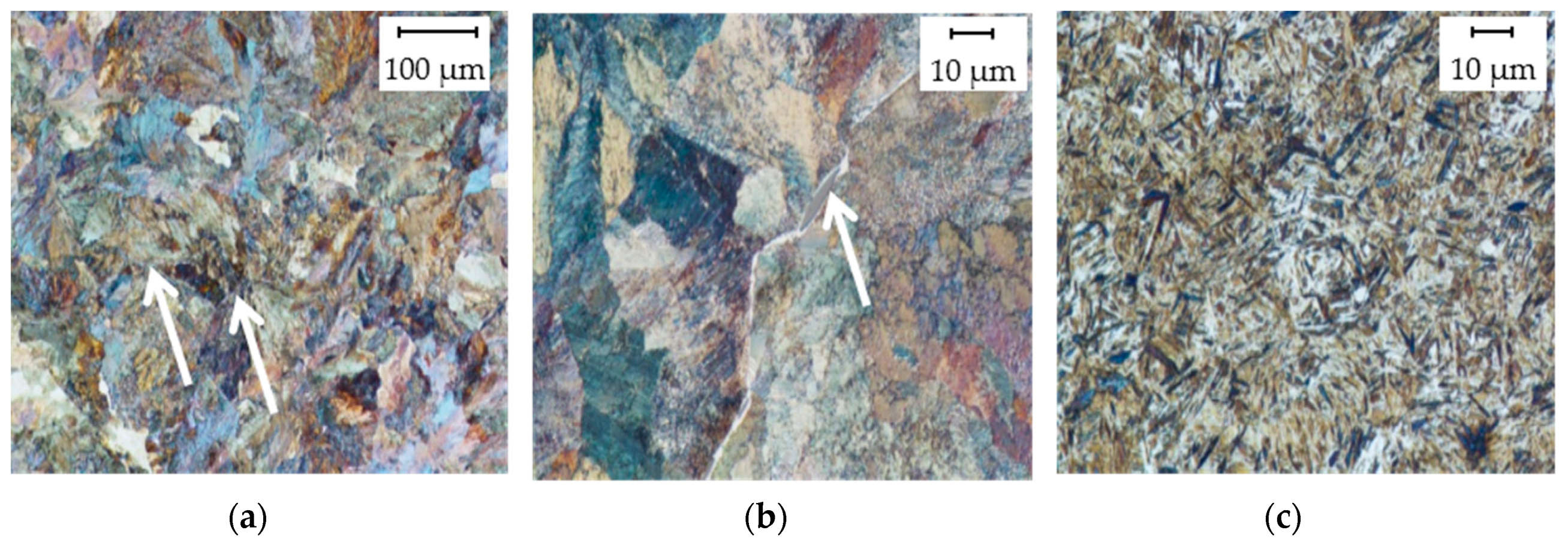
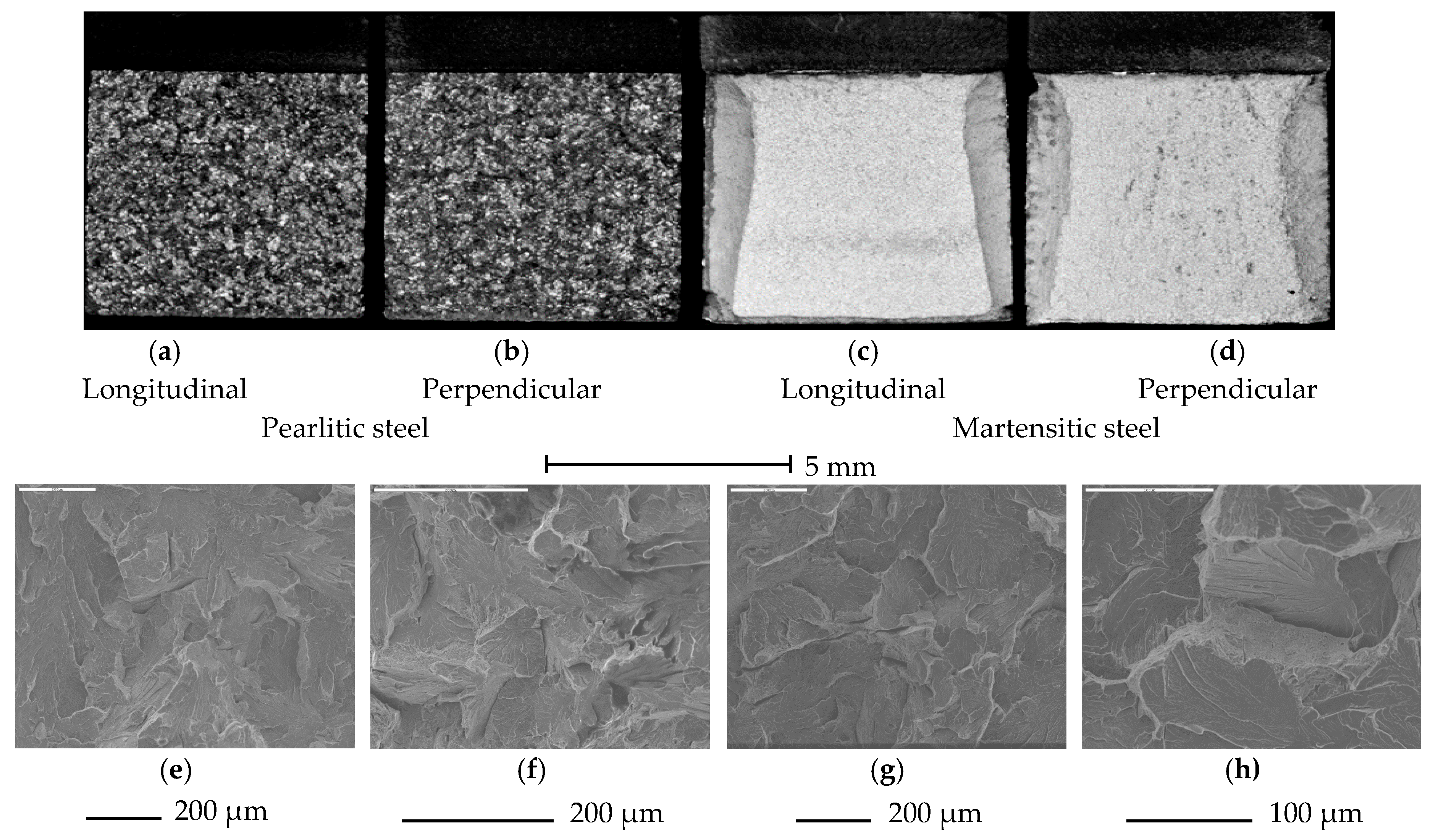

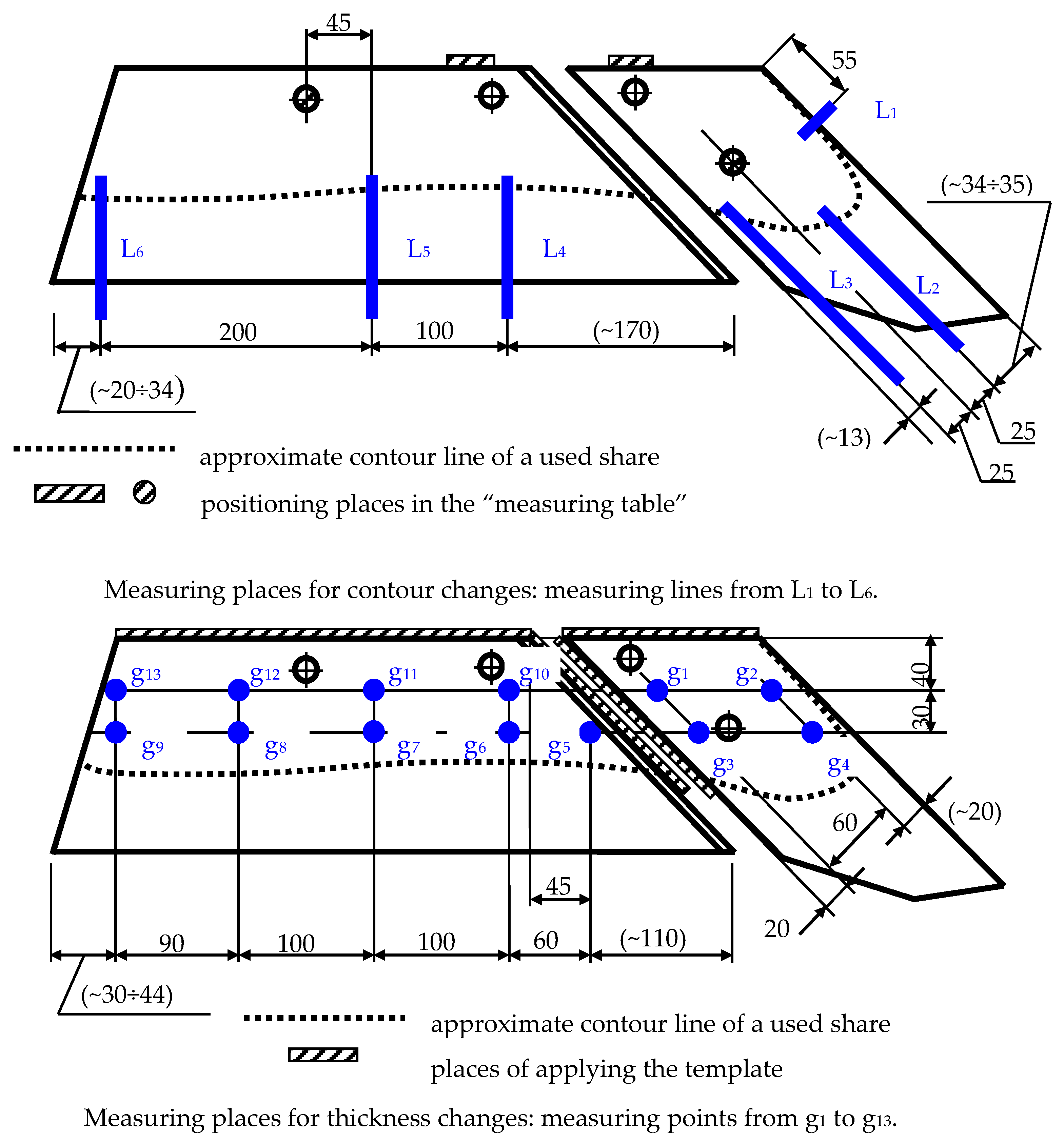
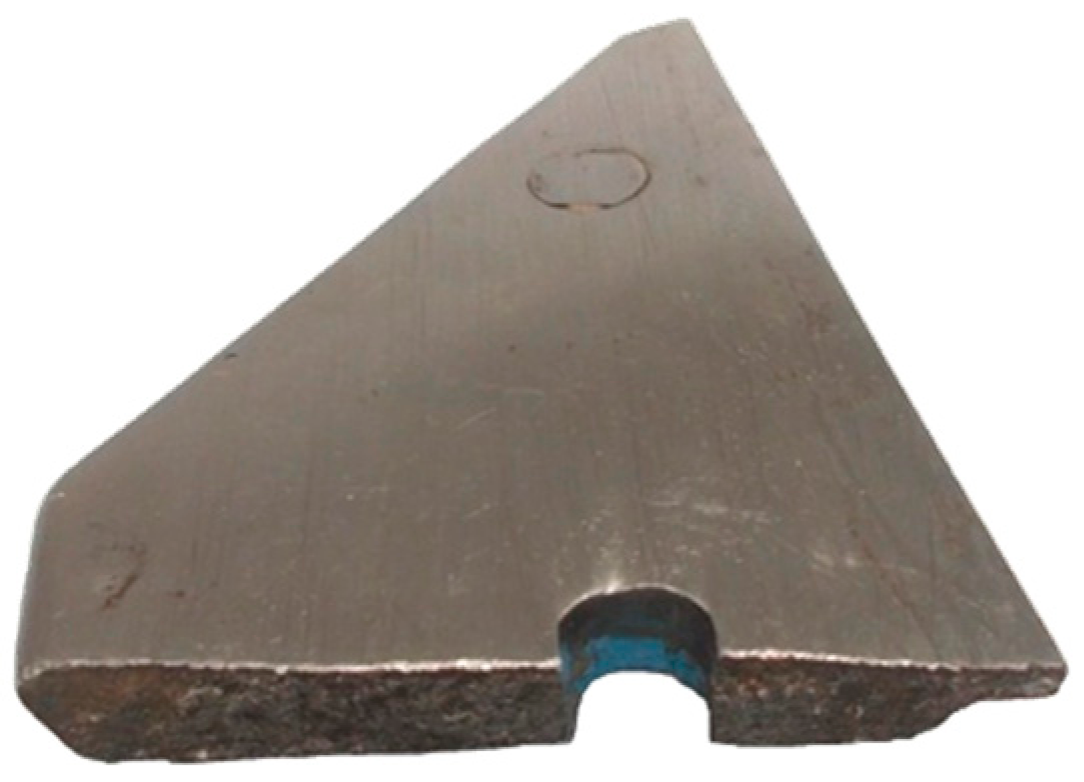


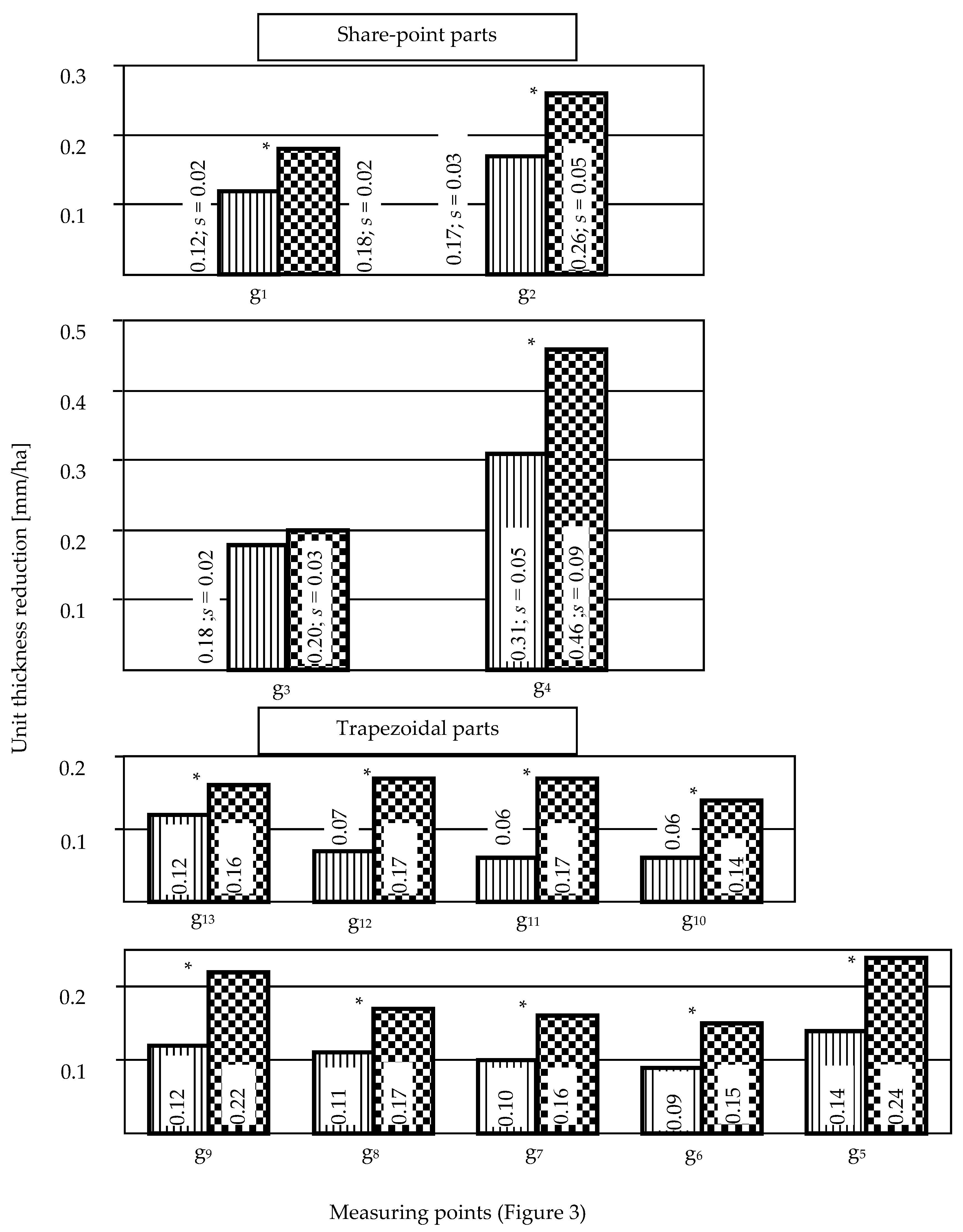
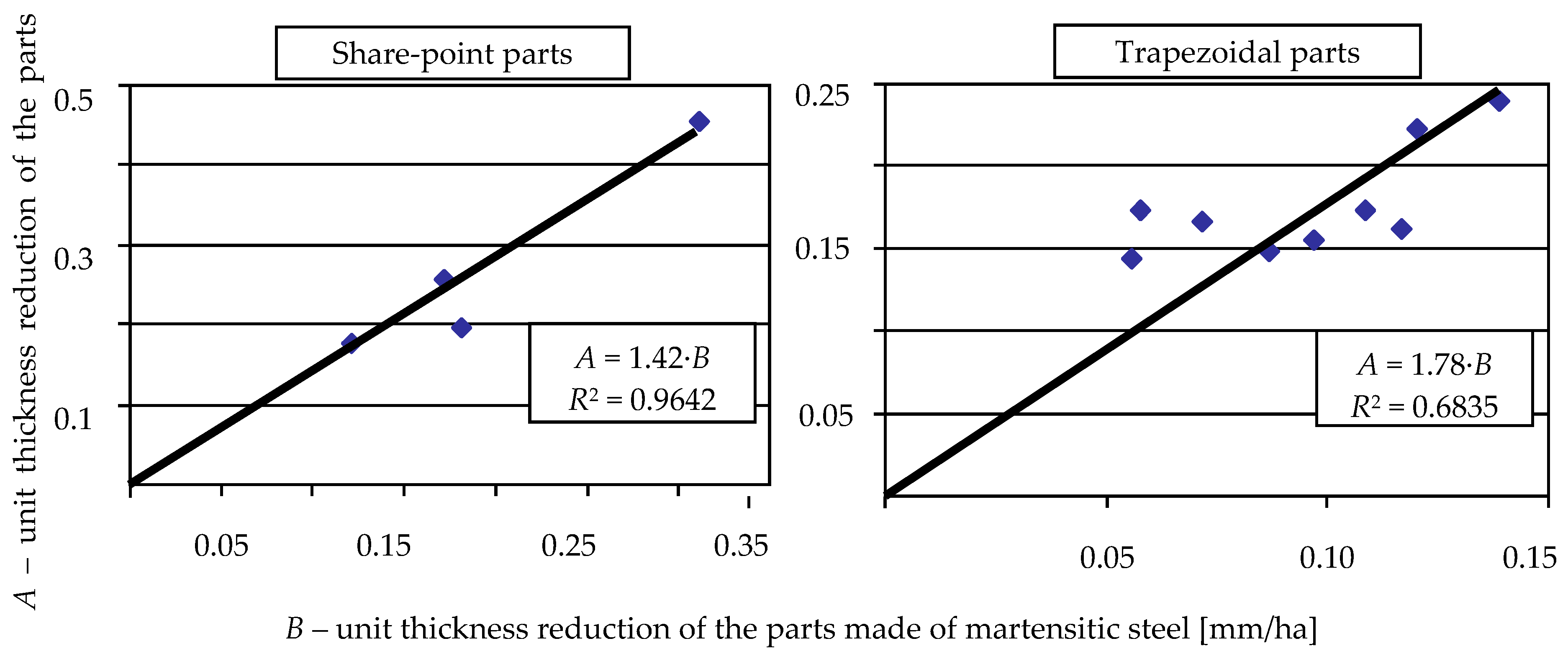
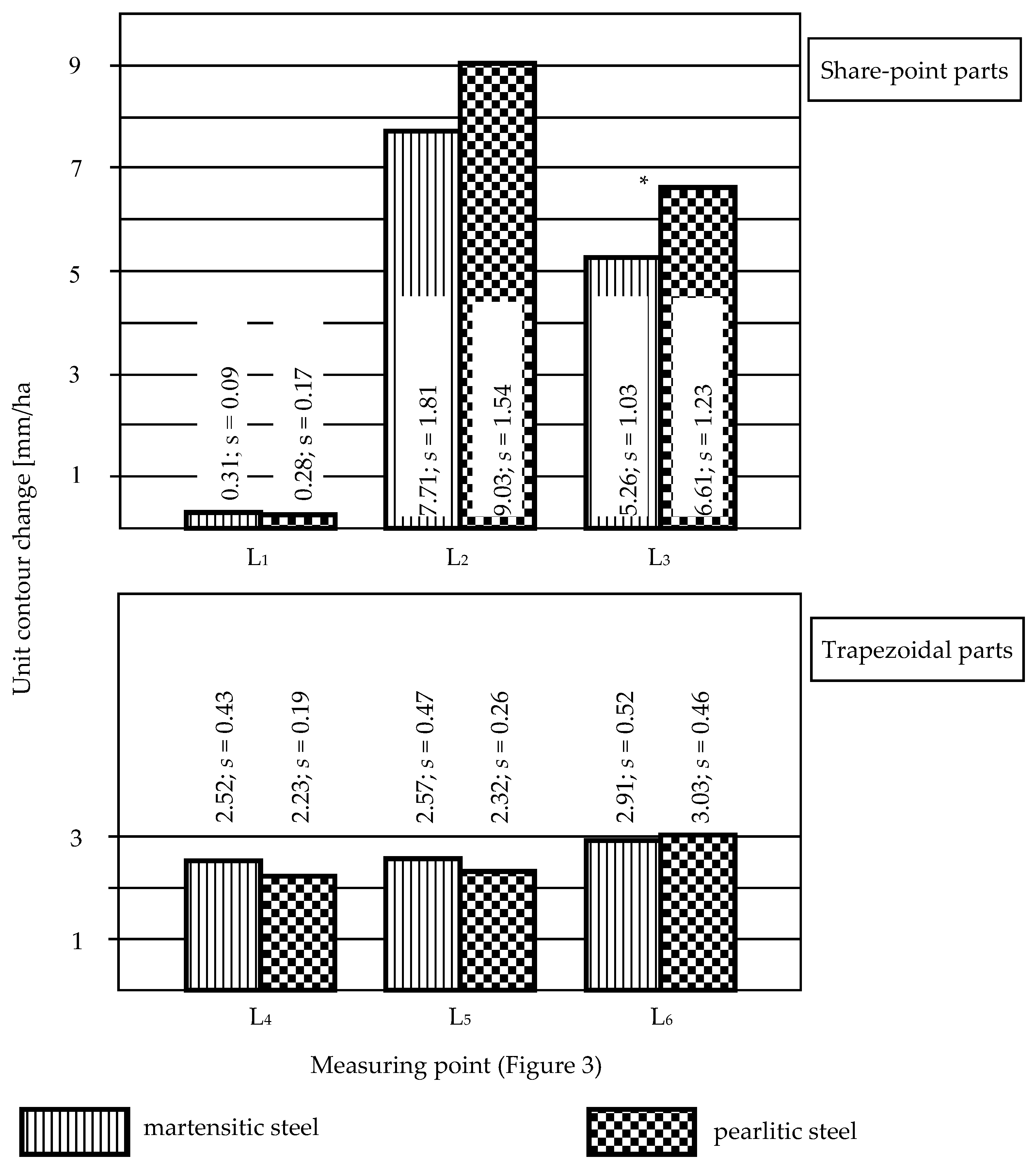

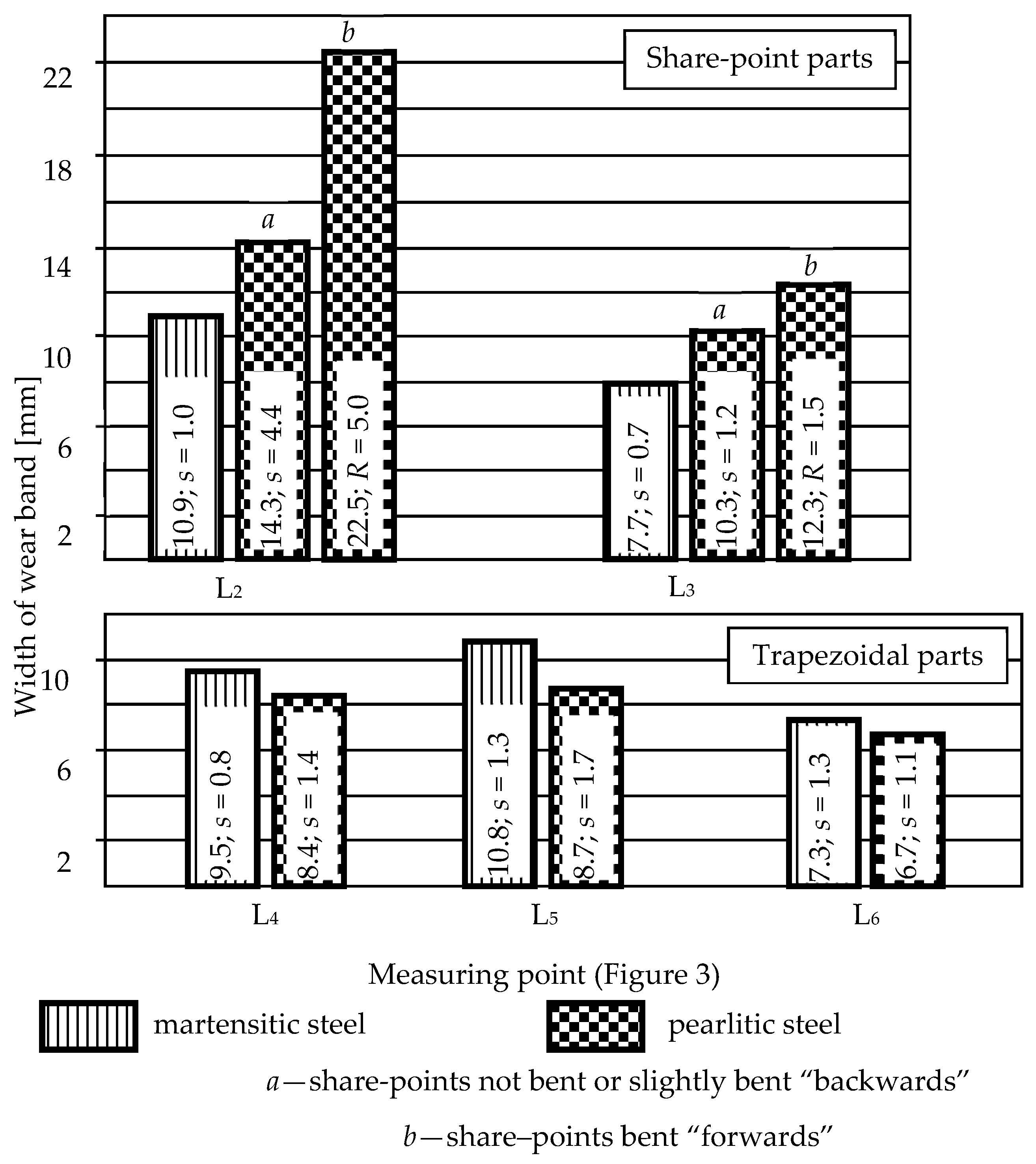
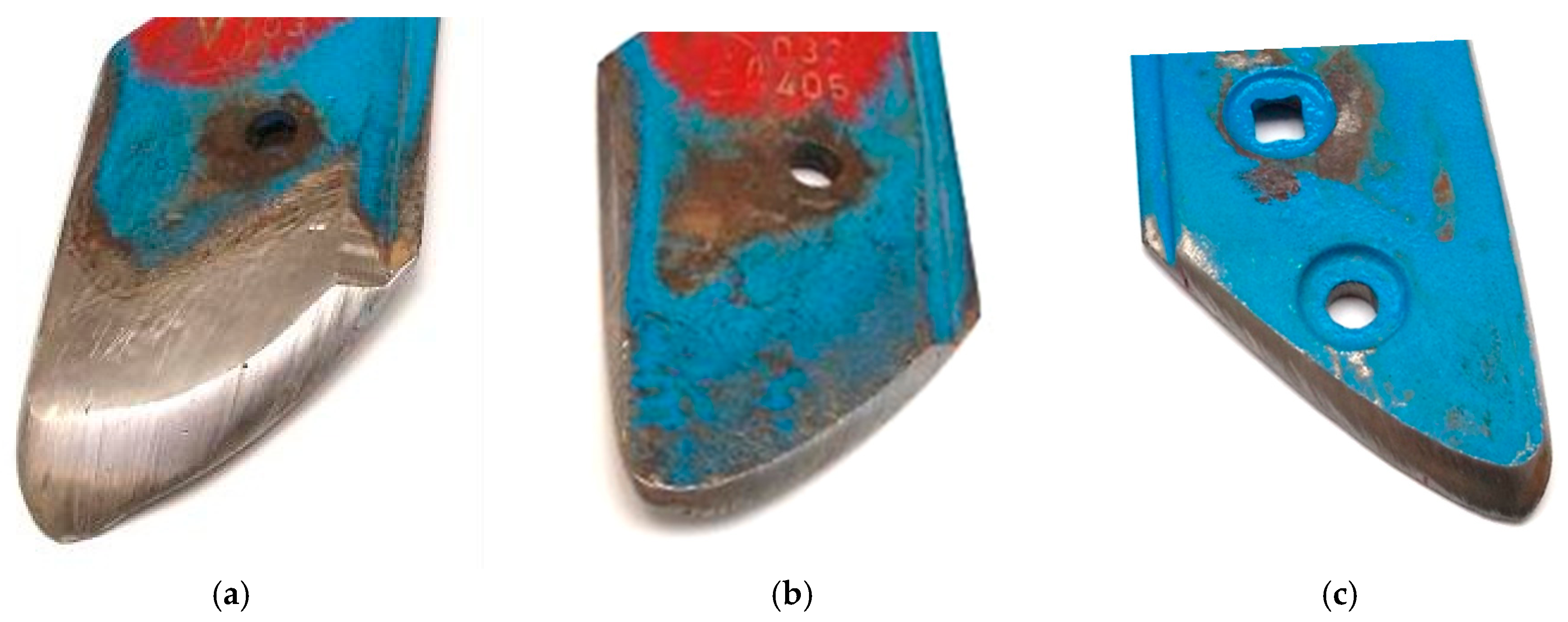


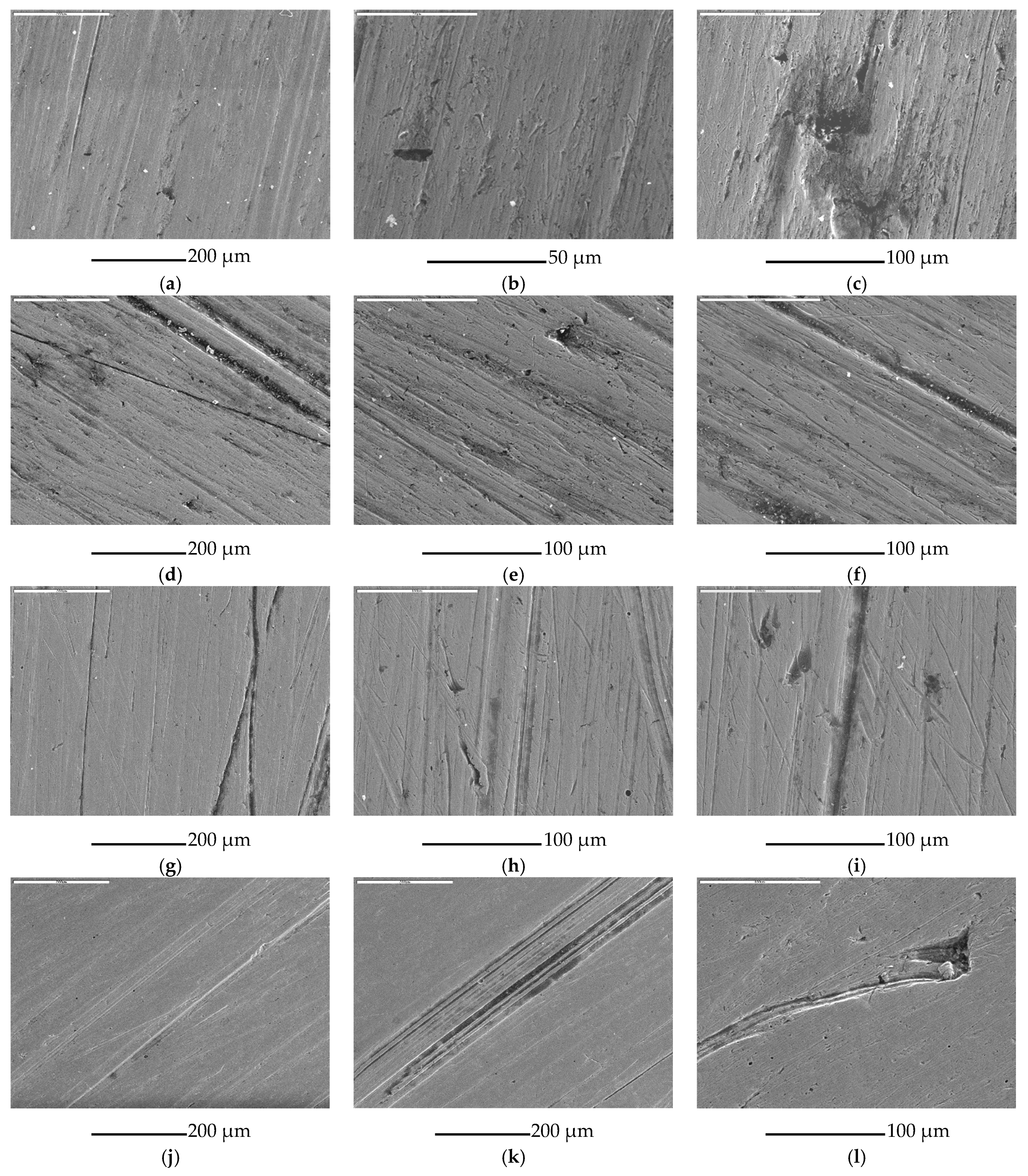
| Element | Concentration [wt %] | |
|---|---|---|
| Pearlitic Steel | Martensitic Steel | |
| C | 0.809 | 0.362 |
| Mn | 0.884 | 1.270 |
| Si | 0.214 | 0.230 |
| P | 0.022 | 0.013 |
| S | 0.025 | 0.006 |
| Cr | 0.061 | 0.256 |
| Ni | 0.058 | 0.084 |
| Mo | 0.005 | 0.019 |
| V | 0.001 | 0.000 |
| Cu | 0.074 | 0.138 |
| Al | 0.016 | 0.031 |
| Ti | 0.002 | 0.043 |
| Co | 0.019 | 0.005 |
| As | 0.032 | 0.000 |
| B | 0.0004 | 0.0023 |
| Pb | 0.002 | 0.002 |
| Zr | 0.008 | 0.004 |
| Fe | Rem. | Rem. |
| Parameter | Material | ||||
|---|---|---|---|---|---|
| Pearlitic Steel | Martensitic Steel | ||||
| Hardness [HBW] | share-point | 258.0 | s = 4.7 | 476.0 | s = 3.5 |
| trapezoidal part | 265.4 | s = 2.8 | 472.2 | s = 1.8 | |
| Impact strength [J/cm2]—relation to plastic working direction | longitudinal | 4 | s = 0.3 | 37 | s = 0.3 |
| perpendicular | 3 | s = 0.3 | 25 | s = 2.6 | |
| Tensile strength Rm [MPa] | 911 | s = 99 | 1833 | s = 40 | |
| Proof stress Rp0.2 [MPa] | 494 | s = 70 | 1482 | s = 35 | |
| Ultimate elongation A [%] | 10 | s = 1.0 | 10 | s = 0.4 | |
| Designations | ||||||||||
|---|---|---|---|---|---|---|---|---|---|---|
 | ||||||||||
| Ploughshare Material | Dimensions [mm] | |||||||||
| Share-Points | Trapezoidal Parts | W10 | ||||||||
| W1 | W2 | W3 | W4/a | W5/a | W6 | W7 | W8 | W9/a | ||
| Martensitic steel | 97 | 335 | 9–15 1) | 28/3 | 27/3 | 496 | 149 | 11 | 42/4 | 650 |
| Pearlitic steel | 99 | 338 | 12–16 1) | 28/5 | 25/5 | 480 | 146 | 12–13 | 30/5 | 643 |
| Mass [g] | ||||||||||
| Martensitic steel | 1846.6 | s = 22.0 | 4588.3 | s = 19.2 | ||||||
| Pearlitic steel | 2157.4 | s = 38.0 | 4907.4 | s = 52.3 | ||||||
| Quantity | Determined Average Value | Soil Layer | |
|---|---|---|---|
| Percentages of soil grades in tillable layer of the cultivated area [%] | sandy loams and loams | 63 | Tillable layer |
| loamy sands | 34 | ||
| sands | 3 | ||
| Percentage of skeleton particles (fraction 2 to 30 mm) [%] | 2.4; s = 1.0 | ||
| Stoniness | fine stones (3–14 cm): 15 t/ha; s = 8 (168,000 pcs./ha; s = 80,000) large stones: 28 pcs./ha; s = 31 | ||
| Reaction [pHKCL] | 6.07–6.33 | ||
| Humus content [%] | 1.78; s = 0.25 | ||
| Actual humidity [wt %] | 13.5; s = 1.8 13.1; s = 1.3 | 0–15 cm 15–30 cm | |
| Volumetric density [g/cm3] | 1.45; s = 0.06 1.49; s = 0.13 | 0–15 cm 15–30 cm | |
| Consistency [kPa] | 789; s = 166 1866; s = 496 | 0–15 cm 15–30 cm | |
| Shearing stresses [kPa] | 47.0; s = 10.3 65.2; s = 19.2 | 0–15 cm 15–30 cm | |
| Working width [m] | 0.45; s = 0.04 | ||
| Working depth [cm] | 20.5; s = 3.5 | ||
| Speed [m/s] | 2.78; s = 0.25 | ||
| Sample No. | Percentages of A Granulometric Fraction [%] | Granulometric Group | |||||||
|---|---|---|---|---|---|---|---|---|---|
| Sand | Silt | Clay | |||||||
| very Coarse 1.0 < d ≤ 2.0 | Coarse 0.5 < d ≤ 1.0 | Medium 0.25 < d ≤ 0.5 | Fine 0.10 < d ≤ 0.25 | very Fine 0.05 < d ≤ 0.10 | Coarse 0.02 < d ≤ 0.05 | Fine 0.002 < d ≤ 0.02 | d ≤ 0.002 | ||
| 1 | 1.7 | 5.8 | 11.7 | 34.2 | 20.1 | 10.8 | 10.8 | 4.9 | FSL |
| 2 | 1.8 | 6.5 | 12.3 | 30.9 | 19.0 | 12.8 | 10.8 | 5.9 | FSL |
| 3 | 1.7 | 6.3 | 10.9 | 22.4 | 23.4 | 10.8 | 14.7 | 9.8 | SL |
| 4 | 1.9 | 5.4 | 11.1 | 34.4 | 19.7 | 8.8 | 12.8 | 5.9 | FSL |
| 5 | 1.1 | 3.6 | 6.9 | 15.2 | 22.7 | 24.8 | 15.8 | 9.9 | L |
| 6 | 1.4 | 4.5 | 9.3 | 36.4 | 23.8 | 6.9 | 11.8 | 5.9 | FSL |
© 2017 by the authors. Licensee MDPI, Basel, Switzerland. This article is an open access article distributed under the terms and conditions of the Creative Commons Attribution (CC BY) license (http://creativecommons.org/licenses/by/4.0/).
Share and Cite
Stawicki, T.; Białobrzeska, B.; Kostencki, P. Tribological Properties of Plough Shares Made of Pearlitic and Martensitic Steels. Metals 2017, 7, 139. https://doi.org/10.3390/met7040139
Stawicki T, Białobrzeska B, Kostencki P. Tribological Properties of Plough Shares Made of Pearlitic and Martensitic Steels. Metals. 2017; 7(4):139. https://doi.org/10.3390/met7040139
Chicago/Turabian StyleStawicki, Tomasz, Beata Białobrzeska, and Piotr Kostencki. 2017. "Tribological Properties of Plough Shares Made of Pearlitic and Martensitic Steels" Metals 7, no. 4: 139. https://doi.org/10.3390/met7040139
APA StyleStawicki, T., Białobrzeska, B., & Kostencki, P. (2017). Tribological Properties of Plough Shares Made of Pearlitic and Martensitic Steels. Metals, 7(4), 139. https://doi.org/10.3390/met7040139






